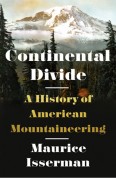Continental Divide: A History of American Mountaineering
By Maurice Isserman
W.W. Norton & Company, 2016; 436 pages, $28.95
In this wide-ranging history of American climbing, Hamilton College Professor Maurice Isserman writes that during colonial times, New Englanders viewed mountains as exceedingly unpleasant places, the abode of wild beasts and unfriendly natives. In 1642, when colonist Darby Field earned the distinction of being the first recorded climber of European descent, if not birth, to scale Mount Washington, accompanied by two Indian—most likely, local Pequawket—companions, he was regarded as more than a little bit crazy by his neighbors.
Four centuries later, mountains are treasured sources of spiritual and physical renewal, places that sane and healthy people go to get grounded. Well-worn trails lead to most peaks, and climbing walls have become standard features of gyms. On summer days, the sheer face of El Capitan in Yosemite National Park, once regarded as unscalable, is a vertical freeway for advanced alpinists. The Darby Fields of today, those perhaps still a bit crazy after all these years, may be the extreme sportsmen who seek the hardest routes up peaks in Alaska, the Himalayas, and other still-wild ranges—though they might demur that they are the sanest and healthiest of us all.
Isserman’s narrative takes us through four centuries of American climbing with a view to the intellectual and social forces that changed our attitudes to altitude. Many pioneering American mountaineers in the eighteenth and nineteenth centuries were understandably not leisure-time athletes, but trappers, prospectors, and government-sponsored explorers. Yale-educated Josiah Dwight Whitney, for example, led a geological survey of California between 1860 and 1863, making the first ascents of some of the most rugged peaks of the West Coast, producing detailed geological charts, and bringing back extensive collections of rocks and fossils. John C. Fremont, Zebulon Pike, and Stephen H. Long, all explorers, are memorialized on maps of Western mountains.
As cartographers filled in blank areas and settlement advanced, a love affair with high places spread to ordinary Americans. The transcendentalists of the 1800s wrote with reverence about seeking God in untamed nature—Thoreau and Emerson frequently climbed Mount Monadnock in New Hampshire—while landscape artists of the Hudson River School, notably Thomas Moran and Thomas Cole, produced romanticized paintings of mountain scenes that sparked public admiration. Outdoor enthusiasts and preservationists Edward Charles Pickering and Samuel Hubbard Scudder founded the Appalachian Mountain Club in the east and John Muir founded the Sierra Club in the west, both organizations still going strong.
Isserman’s eye to the broader issues of culture, however, doesn’t keep him from spinning chilling tales of are-you-serious ascents, daredevil traverses, and tragic falls by legendary figures in the American mountainclimbing community. The “Brotherhood of the Rope” (which was, indeed, a brotherhood, being composed mostly of elite, Ivy-League educated men), brought American mountaineering to maturity. Its members pioneered remote routes in the Rockies and Alaska, and mounted high-tech expeditions to the Himalayas, providing Isserman some of his most exciting material. No one who enjoys the outdoors will fail to find suspense and enlightenment in this chronicle of the enterprising and sometimes foolhardy people who opened Americans’ eyes to the rigors and rewards which can be found in the world’s high places.
